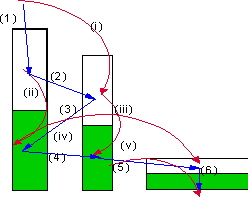Theory
Interception, i.e. the storage of rain water, irrigation water or snow on leaves, can optionally be accounted for in the CoupModel (see switch PrecInterception).The basic idea behind the interception process is that a water storage exists on the leaf surfaces from which water can evaporate directly back to the atmosphere, be temporarily stored or form throughfall to the soil or the snow according to:
where ΔSi is the change of intercepted water/snow in the canopy, P is precipitation, Eia is the evaporation of intercepted water and qth is the throughfall. These variables are described in more detail in this section.
Snow interception can optionally be simulated (see switch SnowInterception), which means that the interception capacity is dependent on the relative amount of liquid and frozen intercepted water. If irrigation water is added in the simulation, the amount of water that is irrigated from above the canopy can be intercepted, and is therefore implicitly included in the term “Precipitation, P”.
There are different structures for the path of water depending on whether the approach with multiple plants is used or not. In the case of a single big leaf, only one storage is considered. In case of multiple canopies each plant is divided into an upper and a lower compartment (see Figure 3.4).
Figure 3.4. The interception process. Direct water fluxes from layer to layer are shown with blue lines and arabic numbers whereas the bypassing water fluxes are shown with red lines and roman numbers.
 Interception rate and
interception storage
Interception rate and
interception storage

